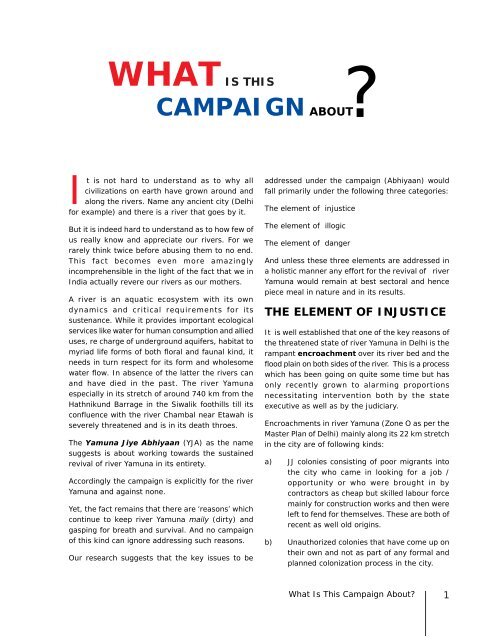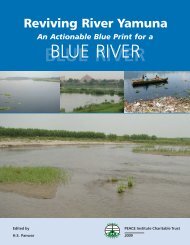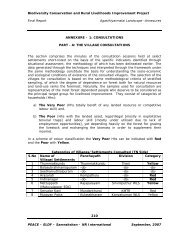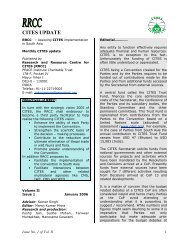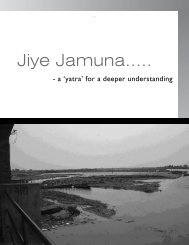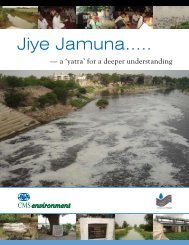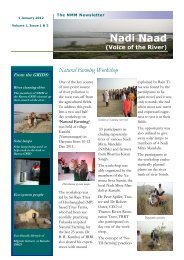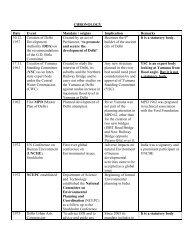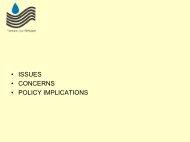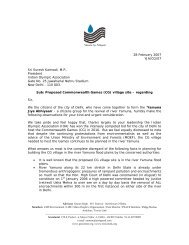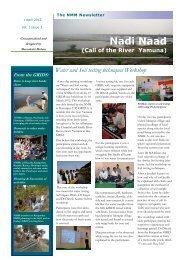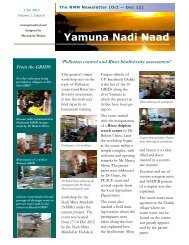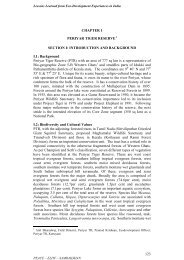What Is This Campaign About?
What Is This Campaign About?
What Is This Campaign About?
You also want an ePaper? Increase the reach of your titles
YUMPU automatically turns print PDFs into web optimized ePapers that Google loves.
WHAT IS THIS<br />
CAMPAIGN ABOUT?<br />
It is not hard to understand as to why all<br />
civilizations on earth have grown around and<br />
along the rivers. Name any ancient city (Delhi<br />
for example) and there is a river that goes by it.<br />
But it is indeed hard to understand as to how few of<br />
us really know and appreciate our rivers. For we<br />
rarely think twice before abusing them to no end.<br />
<strong>This</strong> fact becomes even more amazingly<br />
incomprehensible in the light of the fact that we in<br />
India actually revere our rivers as our mothers.<br />
A river is an aquatic ecosystem with its own<br />
dynamics and critical requirements for its<br />
sustenance. While it provides important ecological<br />
services like water for human consumption and allied<br />
uses, re charge of underground aquifers, habitat to<br />
myriad life forms of both floral and faunal kind, it<br />
needs in turn respect for its form and wholesome<br />
water flow. In absence of the latter the rivers can<br />
and have died in the past. The river Yamuna<br />
especially in its stretch of around 740 km from the<br />
Hathnikund Barrage in the Siwalik foothills till its<br />
confluence with the river Chambal near Etawah is<br />
severely threatened and is in its death throes.<br />
The Yamuna Jiye Abhiyaan (YJA) as the name<br />
suggests is about working towards the sustained<br />
revival of river Yamuna in its entirety.<br />
Accordingly the campaign is explicitly for the river<br />
Yamuna and against none.<br />
Yet, the fact remains that there are ‘reasons’ which<br />
continue to keep river Yamuna maily (dirty) and<br />
gasping for breath and survival. And no campaign<br />
of this kind can ignore addressing such reasons.<br />
Our research suggests that the key issues to be<br />
addressed under the campaign (Abhiyaan) would<br />
fall primarily under the following three categories:<br />
The element of injustice<br />
The element of illogic<br />
The element of danger<br />
And unless these three elements are addressed in<br />
a holistic manner any effort for the revival of river<br />
Yamuna would remain at best sectoral and hence<br />
piece meal in nature and in its results.<br />
THE ELEMENT OF INJUSTICE<br />
It is well established that one of the key reasons of<br />
the threatened state of river Yamuna in Delhi is the<br />
rampant encroachment over its river bed and the<br />
flood plain on both sides of the river. <strong>This</strong> is a process<br />
which has been going on quite some time but has<br />
only recently grown to alarming proportions<br />
necessitating intervention both by the state<br />
executive as well as by the judiciary.<br />
Encroachments in river Yamuna (Zone O as per the<br />
Master Plan of Delhi) mainly along its 22 km stretch<br />
in the city are of following kinds:<br />
a) JJ colonies consisting of poor migrants into<br />
the city who came in looking for a job /<br />
opportunity or who were brought in by<br />
contractors as cheap but skilled labour force<br />
mainly for construction works and then were<br />
left to fend for themselves. These are both of<br />
recent as well old origins.<br />
b) Unauthorized colonies that have come up on<br />
their own and not as part of any formal and<br />
planned colonization process in the city.<br />
<strong>What</strong> <strong>Is</strong> <strong>This</strong> <strong>Campaign</strong> <strong>About</strong>?<br />
1
c) Structures created by the state in an ad hoc<br />
or planned manner.<br />
It is understood that an encroachment threatening<br />
an ecosystem is bad and is wrong irrespective of its<br />
origin, nature or legal status.<br />
Fortunately both the Supreme Court (SC) and the<br />
High Court of Delhi have been seized of this problem<br />
and have directed the state for taking action against<br />
encroachers from time to time ever since 1992 when<br />
an enlightened citizen of Delhi (Comdr Sureshwar<br />
D Sinha) first brought up the matter of the sad state<br />
of river Yamuna before the Hon SC.<br />
The worst irony and gross injustice happens when<br />
the lands which a re reportedly ‘recovered’ from<br />
During 2006 while JJ colonies in river flood plain between the<br />
Shahadara Bridge and the Nizamuddin Bridge were successfully<br />
relocated (under the supervision of the HC created Justice Usha<br />
Mehra Committee) similar encroachers both in Majnu Ka Tila and<br />
in areas south of DND managed to defy and remain. (one can see<br />
in this picture the Raj ghat Power plant in the back ground which<br />
itself is located in the flood plain)<br />
(Date of Photograph: 28 January 2007)<br />
Construction work going on (picture dated 28 January 2007) in<br />
the lands ‘freed’ from the Yamuna Pushta JJ colony ‘encroachers’<br />
in 2004.<br />
The third kind of injustice happens when the state<br />
in its own wisdom decides to permit either an<br />
Akshardham or a power plant or a Secretariat or a<br />
Metro depot to come up in the same river bed and<br />
flood plain creating thereby the so called ‘authorized’<br />
encroachments.<br />
the encroachers in the name of securing the river<br />
bed and reducing the pollution load from the river<br />
is later put to ‘developmental’ use/s by the same<br />
state.<br />
The other kind of injustice (as happened recently in<br />
2006) happens when as a result of a drive against<br />
encroachment only few get up-rooted and rest who<br />
can ‘influence’ or ‘manage’ remain.<br />
Google picture, showing the under construction, Shastri Park Metro<br />
Station in the river bed<br />
The JJ colonies seen diagonally opposite the metro station (under<br />
construction) in the south of the old railway bridge were removed<br />
and relocated in 2006<br />
2 <strong>What</strong> <strong>Is</strong> <strong>This</strong> <strong>Campaign</strong> <strong>About</strong>?
preventing the revival of river Yamuna. Even the<br />
judiciary while addressing the question of<br />
encroachments in the river has linked it only as a<br />
pollution issue rather than a issue about maintaining<br />
the integrity of the river ecosystem.<br />
While admittedly the rampant pollution of river<br />
Yamuna mainly in its 22 km stretch in Delhi is one<br />
of the major problems facing the river Yamuna it is<br />
firstly the question of the survival of the river as an<br />
ecosystem in its own right which should ideally take<br />
precedence over all other actions. If the river in its<br />
natural form is lost then clean water if ever available<br />
can as well flow in a channelised drain without the<br />
benefits accruing to the multitudes from a river<br />
system.<br />
Yamuna flood plain south of the ITO bridge under conversion<br />
for the Yamuna Depot of the Delhi Metro (Date of Photograph:<br />
28 January 2007)<br />
Focussing on an encroacher only as an existing or<br />
potential polluter automatically targets the residents<br />
of either the JJ colonies or of the unauthorized<br />
colonies since these remaining outside the planned<br />
sewage management schemes of the state are<br />
assumed to be the key polluters. <strong>This</strong> approach<br />
presumes that the river is not getting polluted either<br />
by the power plants, or the metro stations or an<br />
Akhshardham or a games village.<br />
PENNY WISE AND POUND FOOLISH<br />
Signature Bridge or the Najafgarh Drain<br />
The Najafgarh drain that meets the river Yamuna<br />
just down stream of the Wazirabad Barrage (see<br />
picture) is reputedly the most polluting of all the 22<br />
drains feeding the river in Delhi. (Date of<br />
Photograph: 28 January 200)<br />
There is a proposal to raise a games village for the 2010<br />
Commonwealth Games in Delhi spread over 42.5 ha of the Yamuna<br />
flood plain next to the structure called Akshardham.<br />
THE ELEMENT OF ILLOGIC<br />
MISSING THE WOODS FOR THE TREES<br />
Treating an encroacher only as a polluter is<br />
missing the larger picture<br />
The state and most others concerned has it seems<br />
till date diagnosed only pollution as the key ill<br />
<strong>What</strong> <strong>Is</strong> <strong>This</strong> <strong>Campaign</strong> <strong>About</strong>?<br />
3
There is a plan to construct a fancy bridge to be<br />
called as a Signature Bridge (see picture )at an<br />
estimated cost of around Rs 450 crores over almost<br />
exactly the place where the the infamous Najafgarh<br />
drain meets the river. (Date of Photograph: 28<br />
January 200)<br />
Now the irony is that while the government of India is seeking loan from the JBIC (Japan Bank for International Cooperation) to clean up<br />
the river Yamuna through activities to be implemented by the Government of Delhi, on the other the Government of Delhi has the luxury<br />
to plan for and erect a fancy bridge in the name of a future landmark (as if this ancient city of ours is short on landmarks to market it to<br />
tourists and others?) of the city.<br />
NB: If such money (at the tax payer’s cost) is indeed available then why can’t it be better<br />
utilized to clean up on a priority basis the very drain on which this bridge is proposed to come<br />
up?<br />
A BIRD IN HAND IS BETTER THAN THE TWO IN THE BUSH<br />
Augmentation of water availability in Delhi<br />
S.No. Source of Raw Water Name of the Plant Installed Capacity in 2021<br />
1 River Yamuna Chandrawal I & II 90 MGD<br />
2 River Yamuna Wazirabad I, II, & III 120 MGD<br />
3 Bhakra Storage Haiderpur I 100 MGD<br />
4 Yamuna Haidepur II 100 MGD<br />
5 Bhakra Storage Nangloi 40 MGD<br />
6 Upper Ganga Canal Bhagirathi 100 MGD<br />
7 Sub-Surface Water Ranney Wells/Tubewells 125 MGD<br />
8 Upper Ganga Canal Sonia Vihar 140 MGD<br />
9 Saving from seepage losses Dwarka 40 MGD<br />
with the constructionof new<br />
parallel lined channel<br />
10 Saving from seepage losses Bawana 20 MGD<br />
with the constructionof new<br />
parallel lined channel<br />
11 Saving from seepage losses Okhla 20 MGD<br />
with the constructionof new<br />
parallel lined channel<br />
12 Recycling of wastewater at water - 45 MGD<br />
treatment plants<br />
TOTAL<br />
940 MGD
Water supply scenario in 2021 (MPD 2021)<br />
Against the above scenario according to Delhi Jal<br />
Board (DJB) the projected demand in 2021 will be<br />
of 1380 MGD at the rate of 60 gpcd for 230 lakh<br />
population in Delhi.<br />
dependence on future dams and sources located<br />
outside the NCTD is being over emphasized.<br />
Clearly the Yamuna flood plain is a precious<br />
To meet this shortfall, according to the MPD-2021<br />
the work on following dams has to be expedited.<br />
There seems to be no other alternative (sic):<br />
(A)<br />
(B)<br />
(C)<br />
Renuka Dam on river Giri in Himachal Pradesh<br />
Kishau Dam on river Tons in Uttaranchal (now<br />
Uttarakhand)<br />
Lakhwar Vyasi Dam on river Yamuna in<br />
Uttaranchal (now Uttarakhand)<br />
According to the Central Ground Water Board<br />
the Yamuna flood plain in the north west, north<br />
east, east and the south districts have a ground<br />
water potential ranging from very large yield<br />
(100 – 280 cmt per hr) to large yield (50 – 100<br />
cmt per hr).<br />
According to a study published in 2004 by Dr P.<br />
Kumar of the Institute for Economic Growth Delhi,<br />
India:<br />
To maintain the ground water recharge potential<br />
of the floodplains, it is imperative to prevent<br />
any fresh civic structures to come up in these<br />
areas.<br />
Any human activity impairing the water recharge<br />
function of the floodplain ecosystem will create<br />
problems not only for the present but future<br />
generation too.<br />
Water recharge function of Yamuna Floodplain<br />
can not only save Rs 51-60 million per annum<br />
for the government of Delhi but it can<br />
substantially help in balancing the demandsupply<br />
gap in provisioning of water for Delhi.<br />
NB: In a scenario like above it is hard to fathom as<br />
to how the planners are over looking the vital<br />
importance and role of the Yamuna flood plain as<br />
the ground water recharge source in the city and<br />
not even talking about protecting this zone as critical<br />
part of the scheme of things in the MPD 2021 while<br />
resource to be zealously protected and NOT a<br />
waste land waiting to be ‘developed’. (Date of<br />
Photograph: 28 January 200)<br />
Say NO to Commonwealth Games 2010 village<br />
in the Yamuna flood plain<br />
Common man’s view of events like the<br />
Commonwealth Games<br />
- It is India and the city of Delhi in particular<br />
that has won the rights for holding the games<br />
from a competing country (Canada in this<br />
instance)<br />
- GOI is the organiser and hence the successful<br />
organisation of such an event is a national<br />
event involving national pride and prestige<br />
- GOI is within its right to spend money and<br />
invest its resources (including land) on such<br />
events<br />
The little appreciated FACTS are<br />
- It is the Indian Olympic Association (IOA)<br />
which is a non government registered<br />
<strong>What</strong> <strong>Is</strong> <strong>This</strong> <strong>Campaign</strong> <strong>About</strong>?<br />
5
Association (just like any other NGO) and<br />
NOT the Government of India (GOI) that bids<br />
for and is primarily responsible for the<br />
successful organisation of such events.<br />
- In other words (just like in Cricket, it is the<br />
Team - India and NOT the Indian team which<br />
is selected and managed by the BCCI) the<br />
Commonwealth Games is NOT an Indian<br />
event but an International games event bid<br />
successfully for being organised in Delhi in<br />
India by the IOA.<br />
- It is well known that the IOA’s last minute<br />
offer of USD 100,000 per member (72 in all)<br />
and the fact that the CG had never taken place<br />
before in India that clinched the bid in IOA’s<br />
favour.<br />
- GOI has reportedly agreed to underwrite all<br />
costs (difference between revenue and<br />
expenditure) for the organisation of the CG<br />
to the IOA.<br />
Lingering questions<br />
- How is the DDA (which is a GOI agency<br />
created by an Act of the Parliament) acting<br />
on behalf of IOA in raising the Games Village<br />
and the other infrastructure in Delhi?<br />
- When, who and how was the GOI enabled<br />
(by the Parliament?) to agree to underwrite<br />
all costs for the organizing of the CG to the<br />
IOA at the tax payer’s expensive?<br />
- How is the GOI accountable to the tax payer<br />
for such largesse?<br />
- Why does Delhi need another Games Village<br />
when a permanent Games Village already<br />
exists in the city (raised in Siri Fort area for<br />
the Asiad in 1982)?<br />
- If a new games village is needed now for the<br />
CG 2010 then would the same story be<br />
repeated the next time around too when<br />
another Games Village be sought to be raised<br />
in Delhi? (It is well known that IOA is bidding<br />
for the Asian Games 2014 to be held in Delhi!)<br />
- Why such events be held only in Delhi<br />
specially when the city is bursting at its seam<br />
in terms of growth and suffers from an acute<br />
shortage of land and woeful civic and other<br />
amenities? (In many other countries such<br />
games are organised in different cities)<br />
- <strong>Is</strong> the Commonwealth Games Federation<br />
(CGF) the parent body of the games aware<br />
that the proposed CG village is slated to be<br />
raised in a river flood plain with the potential<br />
to unleash a growth chain reaction which<br />
could disrupt the river ecosystem for ever?<br />
COMMONWEALTH GAMES 2010 –<br />
RESIDENTIAL PROJECT : SHORTLISTED<br />
APPLICANTS<br />
The following applicants have been shortlisted at<br />
the RFQ stage for invitation to participate in the<br />
RFP Process the Residential Project of the<br />
Commonwealth Games Village.<br />
1. M/S DLF Ltd<br />
2. M/S Omaxe Ltd<br />
3. M/S Nagarjuna Construction Co Ltd<br />
4. M/S Shapoorji Pallonji & Co Ltd<br />
5. M/S Larsen and Toubro Ltd<br />
6. M/S Parsavnath Developers Ltd<br />
7. M/S Ansal Properties and Infrastructure Ltd<br />
8. Consortium of CSCHK-Soma Enterprises<br />
9. Consortium of Namkwang-SPSL-PDI-CMCL<br />
10. Consortium led by Emaar PJSC<br />
11. Consortium of Unitech Ltd-IL&FS-PSDA-FCL<br />
ELEMENT OF DANGER<br />
DON’T EMBRACE CALAMITY<br />
Delhi is Flood Prone<br />
International<br />
Games<br />
COUNTRY YEAR GAMES CITY<br />
India 1951 Asian New Delhi<br />
1982 Asian New Delhi<br />
2010 Commonwealth New Delhi<br />
2014 (bid) Asian Games New Delhi<br />
Australia 1956 Olympics Melbourne<br />
1982 Commonwealth Brisbane<br />
2000 Olympics Sydney<br />
2006 Commonwealth Melbourne<br />
GB 1908 Olympics London<br />
1948 Olympics London<br />
COUNTRY YEAR GAMES CITY<br />
1970 Commonwealth Edinburgh<br />
1986 Commonwealth Edinburgh<br />
2002 Commonwealth Manchester<br />
US 1904 Olympics St Louis<br />
1932 Olympics Los Angeles<br />
1984 Olympics Los Angeles<br />
1996 Olympics Atlanta<br />
Korea 1986 Asian Seoul<br />
1988 Olympics Seoul<br />
2002 Asian Busan<br />
2014 (bid) Asian Incheon
Flood vulnerability (Source: Taranjot Kaur<br />
Gadhok, Senior Fellow, HSMI (HUSDCO), New Delhi)<br />
The city has been experiencing floods of various<br />
magnitudes in the past due to floods in the Yamuna<br />
and the Najafgarh Drain system. The Yamuna<br />
crossed its danger level (fixed at 204.83m) twenty<br />
five times during the last 33 years. Since 1900, Delhi<br />
has experienced six major floods in the years 1924,<br />
1947, 1976, 1978, 1988 and 1995 when peak level<br />
of Yamuna river was one meter or more above<br />
danger level of 204.49m at old rail bridge (2.66m<br />
above the danger level) occurred on 6 September<br />
1978. The second record peak of 206.92m was on<br />
27 September 1988.<br />
In the recent past, the city experienced high<br />
magnitude floods in 1977, 1978, 1988 and 1995,<br />
causing misery and loss of life and property to the<br />
residents of the city.<br />
Settlment pattern in flood plain<br />
A close analysis of the flood zoning pattern reveals<br />
that the high risk zones are the areas that have<br />
earlier been identified as unplanned or poorly<br />
planned areas having high population densities and<br />
sub standard housing structures. These include<br />
areas of North Delhi, and Trans Yamuna. Some<br />
of the colonies that have come up in these<br />
areas are at levels 3 to 4 meters below the<br />
1978 flood level.<br />
Risk of break in embankments<br />
Protection from the river by embankments lead<br />
to a false sense of safety and development<br />
starts taking place in the shadow of these<br />
embankments. In the event of failure of these<br />
protective works, as has been seen in the form of<br />
breaches during past floods, the effect is devastating<br />
because the pressure of the entire embanked<br />
stretch is released at one point, and it takes the<br />
people by surprise.<br />
European River (Thames or Seine) Model is No<br />
Panacea for River Yamuna<br />
Raw sewage floods River Thames<br />
(Source:www.smh.au/articles)<br />
August 6, 2004<br />
Environment authorities have mounted a major<br />
cleanup operation in London after Tuesday’s<br />
flooding forced hundreds of thousands of tonnes<br />
of raw sewage into the River Thames running<br />
through central London.<br />
The Environment Agency said 600,000 tonnes<br />
of untreated sewage overflowed into the river<br />
as London’s Victorian-era sewers were<br />
overwhelmed by torrential rains that brought<br />
chaos to parts of the city on Tuesday night.<br />
“The overflow has to go somewhere, and the<br />
Thames is the natural place,” a spokeswoman<br />
told Reuters on Wednesday.<br />
Flood scenario in Seine<br />
(Source: Pierre-Alain Roche, 2005)<br />
Studies conducted in the 1990s gave the authorities<br />
an initial warning by estimating the damage from a<br />
flood comparable to that of 1910 at 4.6 billion euros<br />
(1990 scenario). These same studies also estimated<br />
that the disruption caused by a rise in the level of<br />
the Seine equal to that reached during the 1910<br />
flood would affect:<br />
· 70% of metro traffic for 30 to 50 days;<br />
· 50% of RER traffic for 30 to 50 days;<br />
· over 200 000 electricity subscribers;<br />
· over 1 million telephone subscribers;<br />
· around 100 000 gas subscribers;<br />
· 5 household waste processing plants;<br />
· 5 district heating plants;<br />
· 50% of drinking water supplies.<br />
The most recent estimates have raised this figure<br />
to 12 billion euros. The reason for this increase is<br />
that in addition to direct damage there are also the<br />
costs resulting from the loss or disruption of a large<br />
number of public services. The failure of an EDF<br />
transformer affects a much larger area than the area<br />
actually flooded; the same is true of all utility<br />
networks (telecommunications, district heating,<br />
drinking water, drains and sewers, etc. and<br />
obviously, transport networks too ). Like a house<br />
<strong>What</strong> <strong>Is</strong> <strong>This</strong> <strong>Campaign</strong> <strong>About</strong>?<br />
7
of cards collapsing, knock-on effects would spread<br />
the impacts of the flooding to areas far removed<br />
from those actually under water; the estimated costs<br />
of “indirect” damage constantly rise the more they<br />
are studied in greater detail.<br />
Worst Case Scenario in Delhi (25 yrs floods)<br />
(fictional but possible)<br />
It is 20 th July 201…It has been raining incessantly<br />
for the last two days in Delhi. In the hills the rain<br />
had been unusually severe this monsoon.<br />
Unknown to most residents in Delhi, the waters in<br />
river Yamuna have been rising steadily over the last<br />
few days but since this morning the rise had taken<br />
menacing proportions and the authorities in the<br />
railways and the Delhi Metro have started to take<br />
precautionary measures for maintaining the<br />
services. The metereological forecast has at best<br />
been tentative but a storm accompanied by heavy<br />
rains in and around Delhi has been forecasted.<br />
By about 0900 hrs the authorities at the Hathnikund<br />
Barrage in Haryana have informed all concerned that<br />
they can hold no longer and for the safety of the<br />
Barrage large amount of water would have to be<br />
released immediately into the main Yamuna river.<br />
By 1800 hrs the rising Yamuna waters in Delhi have<br />
resulted in sluices in the Wazirabad Barrage as well<br />
as the Yamuna and the Okhla Barrage to be opened<br />
in full. Surging Yamuna waters have breached all<br />
the minor embankments and spread all over its<br />
whatever remaining flood plains. Flood waters have<br />
entered the Sonia Vihar areas in East Delhi including<br />
the CRPF camp and the DJB water works colony.<br />
The unfinished Signature Bridge is tantalizingly<br />
perched over the torrential waters. The Yamuna<br />
Pushta embankment is about to be breached. All<br />
Metro operations to and from the Shastri Park and<br />
the Yamuna station have been brought to a complete<br />
halt. Waters have entered the Akshardham temple<br />
and emergency evacuation of men and material from<br />
there has been taken up on war footing. The<br />
residents in the CG village apartments and the<br />
shopping centre have been advised to move to safer<br />
places. With fading lights due to torrential rains the<br />
evacuation is proving to be difficult since the electric<br />
supply all over east Delhi has been put off as an<br />
emergency precautionary measure.<br />
By 1900 hrs the Yamuna waters have started to<br />
over top the Yamuna Pushta bund near Geeta Colony<br />
and the water has started to enter low lying areas<br />
in trans Yamuna localities of Geeta Colony and Laxmi<br />
Nagar. There is chaos all over with people in large<br />
numbers moving towards safer areas in Ghaziabad<br />
and beyond. The bridge over the Hindon in<br />
Ghaziabad is chocked with slow moving cars since<br />
the Hindon itself is in spate.<br />
By 2100 hrs the waters have started to threaten<br />
the Yamuna pushta embankment on the east bank<br />
of the river and the authorities are forced to create<br />
a breach to safeguard the embankment which<br />
immediately starts to flood the low lying areas in<br />
trans Yamuna areas even beyond the already<br />
submerged Geeta colony and Shastri Park. Water<br />
by now is all over the Shastri park Metro head<br />
quarters and the Metro operations have all but been<br />
brought to a stand still all over the city. All the<br />
bridges over the river have been declared unsafe<br />
with only the DND still operable. There is a real<br />
possibility that the trans Yamuna area might be cut<br />
off from the rest of the city.<br />
Similarly in the western bank of the river, flood<br />
waters have started to enter Model town and<br />
Mukherji Nagar mainly through the drains which are<br />
now flowing in reverse directions carrying as much<br />
the flood waters as the filth of the drains. Flood<br />
waters have spread all over the Samadhis and<br />
reached the ground floor of the Delhi Secretariat as<br />
also brought to a halt normal operations in all the<br />
power stations located in the west bank of the river.<br />
There is a sense of major catastrophe having<br />
engulfed Delhi something akin to that happened in<br />
Mumbai in the year 2005.<br />
The Prime Minister is in emergency meeting with<br />
all the concerned officials of both the centre and<br />
the Delhi administration including the Chief Minister<br />
and the Lt Governor of Delhi and an urgent action<br />
plan is being put into place to effectively monitor<br />
the situation and to provide immediate relief and<br />
succour to the affected. A flood monitoring control<br />
room is set up in the PMO with the disaster<br />
management group trying to come to grips and<br />
control of the situation.<br />
8 <strong>What</strong> <strong>Is</strong> <strong>This</strong> <strong>Campaign</strong> <strong>About</strong>?
The dawn of July 21 is of little respite. Torrential<br />
rains all over north India continue to play havoc not<br />
just in Delhi with news of devastating floods from<br />
all over north and east India continuing to pour in.<br />
There has been a massive evacuation of people from<br />
affected areas in east Delhi with no immediate<br />
reliable information available about the extent of<br />
loss of life or property in that part of the city. There<br />
is no power available in most parts of the city which<br />
in turn has affected the supply of drinking water to<br />
large areas. All schools and colleges in the city have<br />
been closed down for a week. Attendance in offices<br />
has nose-dived. Rumours have started to run rife<br />
with human causalities figure reportedly rising by<br />
the hour. Media especially the TV continues to<br />
provide round the clock live coverage of the<br />
unprecedented flooding in the city. The situation<br />
changes little for another three days.<br />
It is only after 3 days of unrelenting mayhem from<br />
the flood waters that some semblance of respite is<br />
finally in place although occasional showers still<br />
abound. Affected people start to return to their<br />
homes to retrieve whatever is left untouched by<br />
the flood waters. It is not another week before<br />
skeleton Metro services are put back in operation.<br />
Gaping holes greet a commuter on the roads and<br />
the railways which had ceased operation for almost<br />
two days begin to operate again. The human<br />
casuality figure from the floods are reported to be<br />
in hundreds and the loss to property is topping<br />
thousands of crores of rupees.<br />
Soon reports of water borne diseases spreading<br />
across the city and in nearby suburbs occupy<br />
headlines with the administration coming under<br />
severe scrutiny for its apparent lack of preparedness<br />
and foresight.<br />
A high level enquiry committee after a painstaking<br />
deliberation of over six months reports that the<br />
major reason for the high devastation caused by<br />
the floods was lack of adequate flood plains<br />
remaining in the city with major chunks of it having<br />
been diverted over the years to alternate uses.<br />
Safety estimates about the embankments in the<br />
Yamuna flood plains were all found to be on<br />
unrealistically higher side and hence it was a wrong<br />
decision to permit development of the river flood<br />
plain including the permission granted to the DMRC,<br />
Akshardham, CG village and various other big and<br />
small structures, built in the flood plain. The<br />
committee has recommended immediate review of<br />
the presence of ALL structures standing in the river<br />
flood plain with an option to demolish or phase out<br />
all of them to allow the river flood plain to revert<br />
back to its natural self.<br />
NB: Clearly the Yamuna flood plains need to be<br />
declared inviolate and sacrosanct if for no other<br />
reason than its flood time critical role.<br />
Delhi is Vulnerable to Damage from<br />
Earthquake<br />
According to RN Iyengar (quoted in<br />
GISdevelopment.net)<br />
Delhi, which lies in Seismatic Zone IV, is currently<br />
experiencing mild seismicity. An earthquake of<br />
magnitude 7.0 on the Richter scale, that was once<br />
considered hypothetical, is today a very real<br />
possibility. Keeping in view the forecast of a major<br />
earthquake resistant design consideration, it has<br />
become imperative to size up the earthquake<br />
scenario of the city and increase awareness of<br />
earthquake resistant techniques.<br />
Considering areas affected during past earthquakes<br />
of M - 6.5, it can be expected that such an<br />
earthquake occurring in Delhi could adversly affect<br />
the whole of it with damaging intensities and more<br />
than 50% of the Delhi Metropolitan Area - in terms<br />
of probable damage scenario, earthquake would be<br />
the worst natural disaster for Delhi.<br />
An issue of concern to development managers and<br />
citizens of the city today is that many groups of<br />
Indian and American scientists have forecast a major<br />
seismic upheaval of a probable magnitude 9 on the<br />
Richter scale in North India. The forecast is based<br />
on a detailed study of past Indian earthquakes and<br />
analysis of plate tectonics of the region.<br />
NB: It is well known that within Delhi it is the<br />
Yamuna flood plain area like the recently<br />
developed area of trans - Yamuna which is most<br />
vulnerable to damage from an earth quake. It<br />
is more the reason why no new structure should<br />
be constructed in the remaining Yamuna flood<br />
plain area.<br />
<strong>What</strong> <strong>Is</strong> <strong>This</strong> <strong>Campaign</strong> <strong>About</strong>?<br />
9
WHAT CAN AND<br />
SHOULD BE DONE?<br />
IMMEDIATE MEASURE<br />
- MOEF to notify a River zone Regulation under<br />
the EPA 1986 on the lines of the CRZ<br />
notification<br />
- Delhi government to enact a law for protection<br />
of the river Yamuna flood plain (Zone O in<br />
Delhi) against any unlawful activity including<br />
encroachment (of any kind), pollution and<br />
unauthorized drawal of ground water<br />
- An ordinance declares the constitution of a<br />
ground water reservoir sanctuary in the Zone<br />
O (river Yamuna) in Delhi<br />
- MOUD to accordingly revise the MPD 2021 to<br />
ensure that the Zone O is made inviolate as<br />
recommended both by the MPD 1962 and<br />
1982<br />
- MOEF to move the Hon. SC to seek full<br />
implementation of the water sharing MOU<br />
between the states of UA, HP, UP, Haryana<br />
and Delhi to ensure the minimum flow in the<br />
river Yamuna<br />
- The proposed site of the CG 2010 village is<br />
immediately changed so that no time is lost<br />
in making requisite preparations for the<br />
organization of the said games.<br />
- Similarly any work on the proposed Signature<br />
Bridge is stopped till its feasibility and<br />
desirability is fully established<br />
- All other ongoing earth works (including the<br />
so called Global Village) in river Yamuna are<br />
put on a hold till an environmental review<br />
has been conducted by an independent panel<br />
SHORT TERM MEASURE<br />
- A citizen’s white paper on river Yamuna is<br />
prepared and presented to the nation’s<br />
Parliament through the people’s<br />
representatives<br />
- A thorough professional and transparent<br />
review of YAP is carried out in a time bound<br />
measure and till then all plans to clean the<br />
Yamuna including the so called Thames model<br />
plan is put on a hold<br />
- Delhi government promulgates a rain water<br />
harvest law to ensure that it becomes a<br />
practice enforceable by law<br />
- All existing encroachment in the river bed and<br />
flood plains (both by the state and by private<br />
agencies / individuals) be reviewed and<br />
recommended by a independent panel<br />
consisting of experts and concerned civil<br />
society representatives including the<br />
representatives of the RWAs<br />
- The nation’s parliament and the states<br />
consider the advisability of including the rivers<br />
and the water in to the concurrent list of the<br />
Constitution so that a national law on the vital<br />
issue is possible to enact and implement<br />
- A notification under EPA empowers the MOEF<br />
to get periodical EIAs (post construction)<br />
carried out of all such structures and<br />
constructions which have a potential to either<br />
pollute or endanger the safety of natural<br />
systems like rivers and lakes.<br />
10 <strong>What</strong> <strong>Is</strong> <strong>This</strong> <strong>Campaign</strong> <strong>About</strong>?
LONG TERM MEASURE<br />
- A people’s movement all along the length of<br />
the river (Delhi, Mathura and Agra in<br />
particular) takes up the task of the cleaning<br />
of the river Yamuna with a missionary zeal<br />
- Rain water harvesting becomes a well<br />
accepted norm in the country<br />
- A regulated drawal limited to an annual<br />
recharge estimates from the Ground water<br />
reservoir Sanctuary (Zone O) in Delhi meets<br />
most of the water shortfall in the city<br />
- The proposed dams on the key tributaries of<br />
the river Yamuna are taken up to augment<br />
dry season flow in the river<br />
- The WYC and EYC are repaired to plug<br />
transport losses<br />
- Proposed Satluj- Yamuna link and Sharda –<br />
Yamuna link are established<br />
<strong>What</strong> <strong>Is</strong> <strong>This</strong> <strong>Campaign</strong> <strong>About</strong>?<br />
11


